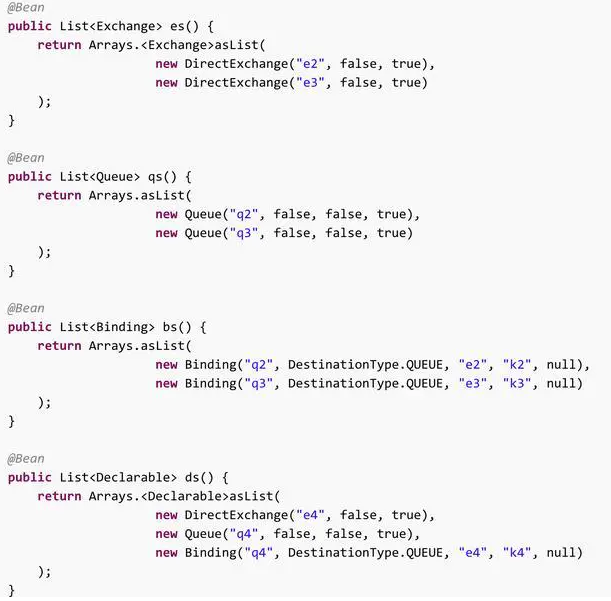前言
在使用Spring整合RabbitMQ时我们主要关注三个核心接口:
- RabbitAdmin: 用于声明交换机 队列 绑定等
- RabbitTemplate: 用于RabbitMQ消息的发送和接收
- MessageListenerContainer: 监听容器 为消息入队提供异步处理
依赖
<dependency>
<groupId>org.springframework.amqp</groupId>
<artifactId>spring-rabbit</artifactId>
<version>1.7.9.RELEASE</version>
</dependency>
配置
可通过以下两种方式进行配置。
- rabbitmq.xml配置文件
<beans xmlns:xsi="http://www.w3.org/2001/XMLSchema-instance" xmlns="http://www.springframework.org/schema/beans" xmlns:rabbit="http://www.springframework.org/schema/rabbit" xsi:schemaLocation="http://www.springframework.org/schema/beans http://www.springframework.org/schema/beans/spring-beans-4.2.xsd http://www.springframework.org/schema/rabbit http://www.springframework.org/schema/rabbit/spring-rabbit-1.6.xsd"> <!-- 消费者和生产者通用配置(begin) -->
<!-- 创建连接工厂 --> <rabbit:connection-factory id="rabbitmqConnectionFactory" host="${rabbitmq_host}" port="${rabbitmq_port}" username="${rabbitmq_user}" password="${rabbitmq_passwd}" virtual-host="${rabbitmq_vhost}" /> <!-- 创建rabbitAdmin --> <rabbit:admin id="connectAdmin" connection-factory="rabbitmqConnectionFactory"/> <!-- 定义消息对象json转换类 --> <bean id="jsonMessageConverter" class="org.springframework.amqp.support.converter.Jackson2JsonMessageConverter" /> <!-- 消费者和生产者通用配置(end) --> <!-- 财务记账接口配置(begin) --> <!-- 创建rabbitTemplate消息发送模版 --> <rabbit:template id="rabbitTemplate" exchange="${mmc_topic_exchange_name}" routing-key="${mmc_routingkey_name}" connection-factory="rabbitmqConnectionFactory" message-converter="jsonMessageConverter"/> <!-- 财务记账接口配置(end) -->
<!-- 关闭订单配置(begin) --> <!-- 创建rabbitTemplate消息发送模版--> <rabbit:template id="orderDelayTemplate" exchange="mmc.order.delay.exchange-delay" connection-factory="rabbitmqConnectionFactory" message-converter="jsonMessageConverter" routing-key="mmc.order.delay.routingkey" /> <!-- 声明监听的Queue的名称 --> <rabbit:queue id="orderQueue" name="mmc.order.delay.queue"/> <!-- 声明exchange的类型为topic --> <rabbit:direct-exchange name="mmc.order.delay.exchange-delay" declared-by="connectAdmin" delayed="true"> <rabbit:bindings> <rabbit:binding queue="mmc.order.delay.queue" key="mmc.order.delay.routingkey"/> </rabbit:bindings> </rabbit:direct-exchange>
<!-- 创建消息监控容器 --> <bean id="messageHandler" class="com.zat.mmc.service.rabbitmq.MessageHandler"/> <rabbit:listener-container connection-factory="rabbitmqConnectionFactory" message-converter="jsonMessageConverter"> <rabbit:listener queues="mmc.order.delay.queue" ref="messageHandler" /> </rabbit:listener-container> <!-- 关闭订单配置(end) --> </beans>
配置文件其实还可以更简单点:
<!-- 消费者和生产者通用配置(begin) -->
<!-- 创建连接 -->
<rabbit:connection-factory id="rabbitmqConnectionFactory" host="${rabbitmq_host}" port="${rabbitmq_port}" username="${rabbitmq_user}" password="${rabbitmq_passwd}" virtual-host="${rabbitmq_vhost}" />
<!-- 创建rabbitAdmin -->
<rabbit:admin id="connectAdmin" connection-factory="rabbitmqConnectionFactory"/>
<!-- 消息对象json转换类 -->
<bean id="jsonMessageConverter" class="org.springframework.amqp.support.converter.Jackson2JsonMessageConverter" />
<!-- 消费者和生产者通用配置(end) -->
<!-- 财务记账接口配置(begin) -->
<!-- 创建rabbitTemplate消息发送模版 -->
<rabbit:template id="rabbitTemplate" exchange="${mmc_topic_exchange_name}" routing-key="${mmc_routingkey_name}" connection-factory="rabbitmqConnectionFactory" message-converter="jsonMessageConverter"/>
<!-- 财务记账接口配置(end) -->
中间定义了交换机,定义了队列,其实都可以省略的,可以到mq的管理后台创建。在代码中定义交换机和队列的好处是在使用时会自动创建它。
- Java配置类
spring在启动时会扫描到Configuration这个注解是一个配置文件的注解。
@Configuration public class RabbitMQConfig { public final static String QUEUE_NAME = "spring-queue"; public final static String EXCHANGE_NAME = "spring-exchange"; public final static String ROUTING_KEY = "spring-key"; // 创建队列 @Bean public Queue queue() { return new Queue(QUEUE_NAME); } // 创建一个 topic 类型的交换器 @Bean public TopicExchange exchange() { return new TopicExchange(EXCHANGE_NAME); } // 使用路由键(routingKey)把队列(Queue)绑定到交换器(Exchange) @Bean public Binding binding(Queue queue, TopicExchange exchange) { return BindingBuilder.bind(queue).to(exchange).with(ROUTING_KEY); } @Bean public ConnectionFactory connectionFactory() { CachingConnectionFactory connectionFactory = new CachingConnectionFactory("xx", 5670); connectionFactory.setUsername("guest"); connectionFactory.setPassword("guest"); return connectionFactory; }
@Bean
public RabbitAdmin rabbitAdmin(ConnectionFactory connectionFactory){
RabbitAdmin rabbitAdmin = new RabbitAdmin(connectionFactory);
// 注意,autoStartup 必须设置为 true,否则 Spring 容器不会加载 RabbitAdmin 类
rabbitAdmin.setAutoStartup(true);
return rabbitAdmin;
}
@Bean public RabbitTemplate rabbitTemplate(ConnectionFactory connectionFactory) { return new RabbitTemplate(connectionFactory); } }
生产者
@Component public class DemoProducer { @Resource(name = "rabbitTemplate") private RabbitTemplate rabbitTemplate; public void sendProducer() { // 生产者发送消息(因为在配置文件里面已经为rabbitTemplate指定了交换机和routing,所以可以省去它们) rabbitTemplate.convertAndSend(jsonObject.toJSONString());
// 生产者往solutionInfo_exchange这个交换机,这个info_queue_key路由中发送消息 rabbitTemplate.convertAndSend("solutionInfo_exchange","info_queue_key", jsonObject.toJSONString()); } }
消费者
package com.rabbitmq.demo @Component public class DemoReceiver extends AbstractAdaptableMessageListener { @Override public void onMessage(Message message, Channel channel) { try { String result=new String(message.getBody(),"UTF-8") log.info("bodyJson:" + result); } catch (Throwable e) { log.error("WechatMsgReceiver exception", e); } } }
其它
- 批量自动声明交换机、队列和绑定
可以批量创建Queue和Exchange,批量创建绑定关系并将其放进List集合中返回使用:

- 手动声明交换机、队列和绑定
可通过RabbitAdmin来实现:
/** * 声明一个direct类型的、持久化、非排他的交换器 */ rabbitAdmin.declareExchange(new DirectExchange(EXCHANGE_NAME, true, false, new HashMap<String, Object>()));
/** * 声明一个持久化、非排他、非自动删除的队列 */ rabbitAdmin.declareQueue(new Queue(QUEUE_NAME, true, false, false, new HashMap<String, Object>()));
/** * 将交换器和队列绑定 */ rabbitAdmin.declareBinding(BindingBuilder.bind(new Queue(QUEUE_NAME)). to(new DirectExchange(EXCHANGE_NAME)).with(ROUTING_KEY));